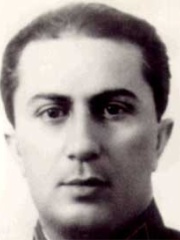
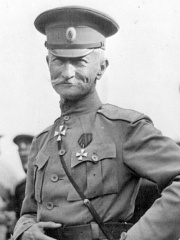
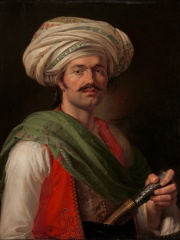
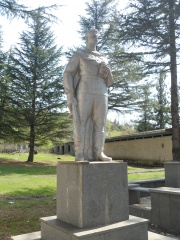
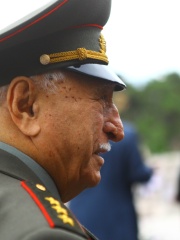
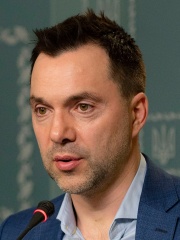
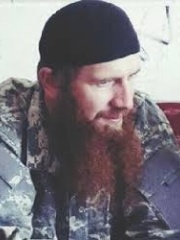
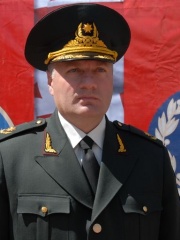
The Most Famous
MILITARY PERSONNELS from Georgia
This page contains a list of the greatest Georgian Military Personnels. The pantheon dataset contains 2,058 Military Personnels, 9 of which were born in Georgia. This makes Georgia the birth place of the 32nd most number of Military Personnels behind Belarus, and Iraq.
Top 9
The following people are considered by Pantheon to be the most legendary Georgian Military Personnels of all time. This list of famous Georgian Military Personnels is sorted by HPI (Historical Popularity Index), a metric that aggregates information on a biography's online popularity.

1. Yakov Dzhugashvili (1907 - 1943)
With an HPI of 73.68, Yakov Dzhugashvili is the most famous Georgian Military Personnel. His biography has been translated into 39 different languages on wikipedia.
Yakov Iosifovich Dzhugashvili (31 March [O.S. 18 March] 1907 – 14 April 1943) was the eldest son of Joseph Stalin, and the only child of Stalin's first wife, Kato Svanidze, who died nine months after his birth. His father, then a young revolutionary in his mid-20s, left the child to be raised by his late wife's family. In 1921, when Dzhugashvili had reached the age of 14 he was brought to Moscow, where his father had become a leading figure in the Bolshevik government, eventually becoming head of the Soviet Union. Disregarded by Stalin, Dzhugashvili was a shy, quiet child who appeared unhappy and attempted suicide several times as a youth. Married twice, Dzhugashvili had three children, two of whom reached adulthood. Dzhugashvili studied to become an engineer, then – on his father's insistence – he enrolled in training to be an artillery officer. He finished his studies weeks before Nazi Germany invaded the Soviet Union in 1941. Sent to the front, he was captured and imprisoned by the Germans and died at the Sachsenhausen concentration camp in 1943 after his father refused to make a deal to secure his release.

2. Aleksei Brusilov (1853 - 1926)
With an HPI of 71.74, Aleksei Brusilov is the 2nd most famous Georgian Military Personnel. His biography has been translated into 52 different languages.
Aleksei Alekseyevich Brusilov (, US also ; Russian: Алексе́й Алексе́евич Бруси́лов, IPA: [ɐlʲɪkˈsʲej ɐlʲɪkˈsʲejɪvʲɪdʑ brʊˈsʲiɫəf]; 31 August [O.S. 19 August] 1853 – 17 March 1926) was a Russian and later Soviet general most noted for the development of new offensive tactics used in the 1916 Brusilov offensive, which was his greatest achievement. Born into an aristocratic military family, Brusilov trained as a cavalry officer, but by 1914 had realized that cavalry was obsolete in an offensive capacity against modern weapons of warfare such as mass adoption of rifled guns, machine guns, and artillery. He is considered a very outstanding general who won many battles against the Austro-Hungarian army. His offensive in 1916 was the final major success of the Tsarist army. In the government, this offensive meant the transfer of the strategic initiative to the Russians and the beginning of preparations for the general offensive of 1917, which, however, was disrupted by the revolution. Despite his noble status and prominent role in the Imperial Russian Army, he sided with the Bolsheviks in the Russian Civil War and aided in the early organization of the Red Army until retiring in 1924. Brusilov is one of the prominent Russian commanders in history. Although not regarded as especially brilliant, he was pragmatic and open to change based on experience; his eponymous offensive succeeded in part from his willingness to properly train and prepare his troops, including in modern artillery and air reconnaissance.

3. Roustam Raza (1783 - 1845)
With an HPI of 64.24, Roustam Raza is the 3rd most famous Georgian Military Personnel. His biography has been translated into 17 different languages.
Roustam Raza (Armenian: Ռուստամ Ռազա; 1783 – 7 December 1845), also known as Roustan or Rustam, was a mamluk bodyguard and secondary valet of Napoleon.

4. Meliton Kantaria (1920 - 1993)
With an HPI of 63.64, Meliton Kantaria is the 4th most famous Georgian Military Personnel. His biography has been translated into 29 different languages.
Meliton Varlamis dze Kantaria or Kantariya (Georgian: მელიტონ ქანთარია; Russian: Мелитон Варламович Кантария, romanized: Meliton Varlamovich Kantariya; 5 October 1920 – 27 December 1993) was a sergeant of the Soviet Army credited with having hoisted the Victory Banner over the Reichstag on 1 May 1945, together with Mikhail Yegorov and Alexei Berest.
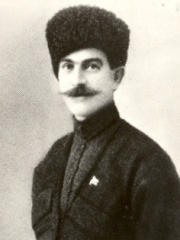
5. Kakutsa Cholokashvili (1888 - 1930)
With an HPI of 57.21, Kakutsa Cholokashvili is the 5th most famous Georgian Military Personnel. His biography has been translated into 16 different languages.
Kaikhosro "Kakutsa" Cholokashvili (Georgian: ქაიხოსრო [ქაქუცა] ჩოლოყაშვილი; French: Kakoutsa Tcholokachvili; Russian: Кайхосро [Какуца] Чолокашвили [Челокаев], Kaikhosro Chelokayev; born 14 July 1888 – 27 June 1930) was a Georgian military officer and a commander of an anti-Soviet guerrilla movement in Georgia. He is regarded as a national hero in Georgia. Born of a noble family, Cholokashvili was a decorated officer of the Imperial Russian Army during World War I. After the Russian Revolution of 1917, he served in the ranks of the Democratic Republic of Georgia. Following the republic's overthrow in a Soviet invasion in 1921, Cholokashvili, with a band of followers, took to the mountains and fought a guerrilla campaign against the Soviet government in the province of Kakheti. After a failed August 1924 anti-Soviet rebellion, during which Cholokashvili commanded the largest single rebel contingent, he fled to France, where he died of tuberculosis in 1930. His remains were reburied, in a state funeral, from the Leuville Cemetery near Paris to the Mtatsminda Pantheon in Tbilisi, Georgia, in 2005. In 2013, he was posthumously awarded the title and Order of National Hero of Georgia.

6. Gurgen Dalibaltayan (1926 - 2015)
With an HPI of 56.39, Gurgen Dalibaltayan is the 6th most famous Georgian Military Personnel. His biography has been translated into 15 different languages.
Gurgen Harutyun Dalibaltayan (Armenian: Գուրգեն Հարությունի Դալիբալթայան; 5 June 1926 – 1 September 2015) was an Armenian military commander. He was the Chief of General Staff of Armenian Armed Forces during the 1992 Battle of Shusha, a battle to capture the city from Azerbaijan. He is credited with devising a strategy to assault the strongly fortified town of Shusha using diversionary attacks against adjacent villages to draw out the defenders of the town while the commander of troops, Arkady Ter-Tatevosyan, encircled the town and cut off reinforcements. His strategy is generally considered impossible, or at least implausible, as he was originally outnumbered. General military tactics suggest a force of three times the defender's size to successfully storm and win.

7. Oleksii Arestovych (b. 1975)
With an HPI of 52.81, Oleksii Arestovych is the 7th most famous Georgian Military Personnel. His biography has been translated into 26 different languages.
Oleksii Mykolaiovych Arestovych (Ukrainian: Олексій Миколайович Арестович; born 3 August 1975) is a Ukrainian political adviser, former military officer, and columnist. He is also a theologian and the founder of the Apeiron School. Arestovych was a speaker for the Trilateral Contact Group on Ukraine. He worked as a Strategic Communications Adviser for the Office of the President of Ukraine from December 2020 to January 2023. He is an active blogger, with almost 830,000 followers on Facebook and more than 1.71 million on YouTube, as of December 2023. Arestovych was among the top 100 bloggers in Ukraine in a poll published by Fakty ICTV in 2019.

8. Abu Omar al-Shishani (1986 - 2016)
With an HPI of 50.86, Abu Omar al-Shishani is the 8th most famous Georgian Military Personnel. His biography has been translated into 28 different languages.
Tarkhan Tayumurazovich Batirashvili (Georgian: თარხან ბათირაშვილი; 11 January 1986 – 10 July 2016), known by his nom de guerre Abu Omar al-Shishani (Arabic: أَبُو عُمَرَ ٱلشِّيشَانِيِّ, romanized: ʾAbū ʿUmar aš-Šīšānī) or Omar al-Shishani, was a Georgian-Chechen jihadist who, as one of the Chechen mujahideen in Syria, served as the leader of the Muhajireen Battalion before defecting and becoming a commander for the Islamic State, and was previously a sergeant in the Georgian Army. A veteran of the 2008 Russo-Georgian War, Batirashvili became a jihadist after being discharged from the Georgian military and served in various command positions with Islamist militant groups fighting in the Syrian Civil War. He became the leader of the Muhajireen Brigade (Emigrants Brigade), and its successor, Jaish al-Muhajireen wal-Ansar (Army of Emigrants and Supporters). In 2013, Batirashvili joined the Islamic State of Iraq and the Levant and rapidly became a senior commander in the organization, directing a series of battles and ultimately earning a seat on ISIL's shura council. The US Treasury Department added Batirashvili to its list of Specially Designated Global Terrorists on 24 September 2014, and seven months later the US government announced a reward up to US$5 million for information leading to his capture. There were several reports of his death throughout 2015 and 2016. The Islamic State announced that he was killed in combat in the Iraqi city of Al-Shirqat, south of Mosul while the Pentagon said that Shishani had likely been killed in U.S. coalition air strikes in Syria, but could not confirm or deny it.

9. Zaza Gogava (b. 1971)
With an HPI of 49.14, Zaza Gogava is the 9th most famous Georgian Military Personnel. His biography has been translated into 21 different languages.
Zaza Gogava (Georgian: ზაზა გოგავა; born July 14, 1971) is a Georgian Major General. He served as a Chief of Joint Staff of the Armed Forces of Georgia from November 2006 to November 2008 and the chief of Border Police from November 2008 to July 2012. Gogava served his compulsory military service in the Soviet Army motorized rifle units from 1989 to 1990. He was one of the first batch of Georgian conscripts to defect from the Soviet forces. He graduated from the Tbilisi State Technical University in 1994 and began his career in the special task group "Omega" within Georgia's security services in 1995. He has since served in various counter-terrorist units and special forces subdivisions, and was further trained in the United States between 1995 and 2002. Gogava was placed in command of the Counter-terrorism Division of Special Operations Center in 2003 and the élite Police Special Tasks Division named after General G. Gulua in 2004. He was appointed Commander of Georgian Special Operations Forces of the Ministry of Defense of Georgia in 2004 and Deputy Chief of the General Staff of the Armed Forces of Georgia in 2006. After the reshuffle within the Ministry of Defense in November 2006, Gogava became the Chief of Joint Staff of the Armed Forces of Georgia. Gogava was later appointed as chief of Border Police, replacing Badri Bitsadze, who had earlier announced his resignation. Gogava served in this position until the reshuffle in the Interior Ministry top brass in July 2012.
People
Pantheon has 9 people classified as Georgian military personnels born between 1783 and 1986. Of these 9, 2 (22.22%) of them are still alive today. The most famous living Georgian military personnels include Oleksii Arestovych, and Zaza Gogava. The most famous deceased Georgian military personnels include Yakov Dzhugashvili, Aleksei Brusilov, and Roustam Raza.
Living Georgian Military Personnels
Go to all RankingsDeceased Georgian Military Personnels
Go to all RankingsYakov Dzhugashvili
1907 - 1943
HPI: 73.68
Aleksei Brusilov
1853 - 1926
HPI: 71.74
Roustam Raza
1783 - 1845
HPI: 64.24
Meliton Kantaria
1920 - 1993
HPI: 63.64
Kakutsa Cholokashvili
1888 - 1930
HPI: 57.21
Gurgen Dalibaltayan
1926 - 2015
HPI: 56.39
Abu Omar al-Shishani
1986 - 2016
HPI: 50.86
Overlapping Lives
Which Military Personnels were alive at the same time? This visualization shows the lifespans of the 6 most globally memorable Military Personnels since 1700.

